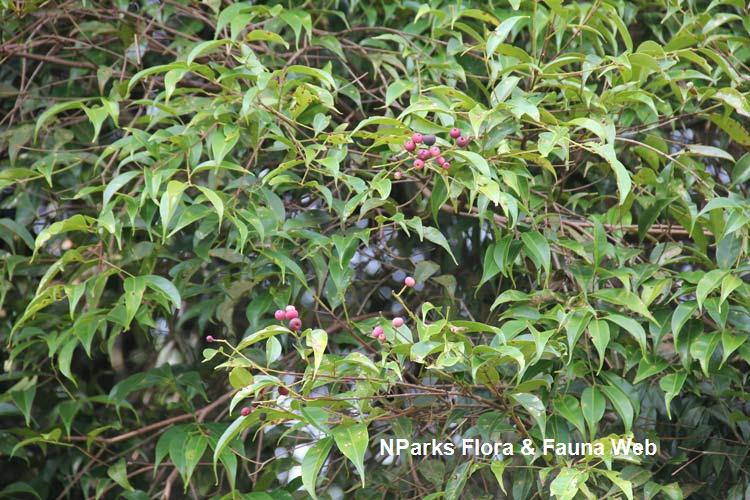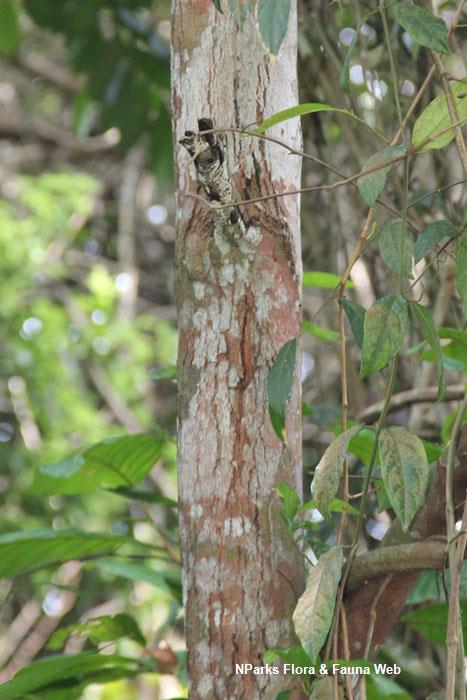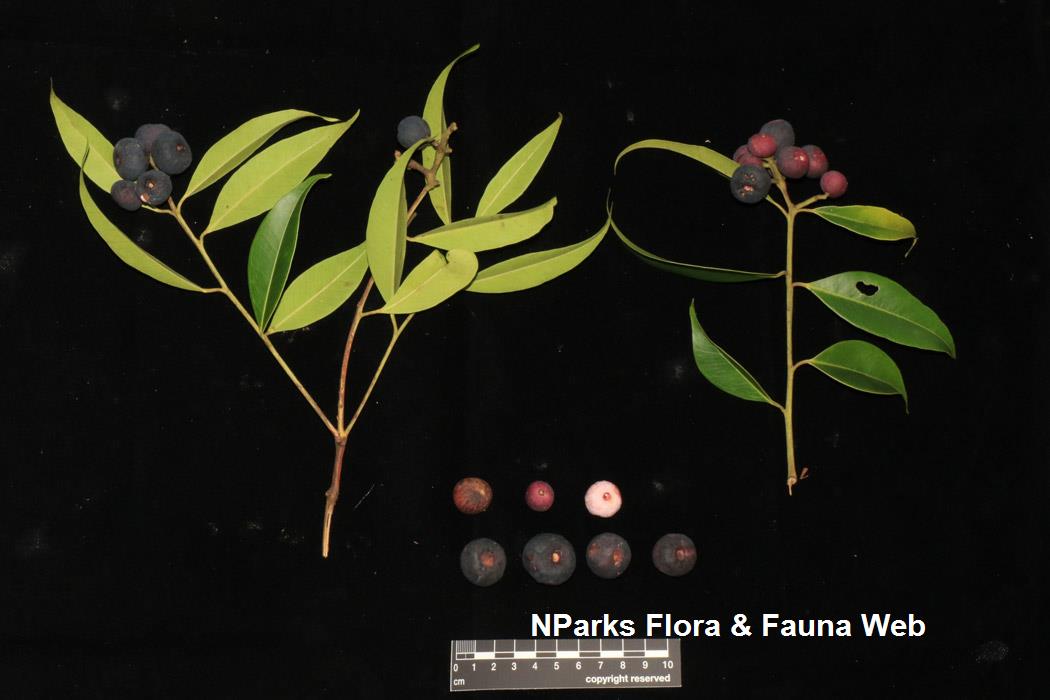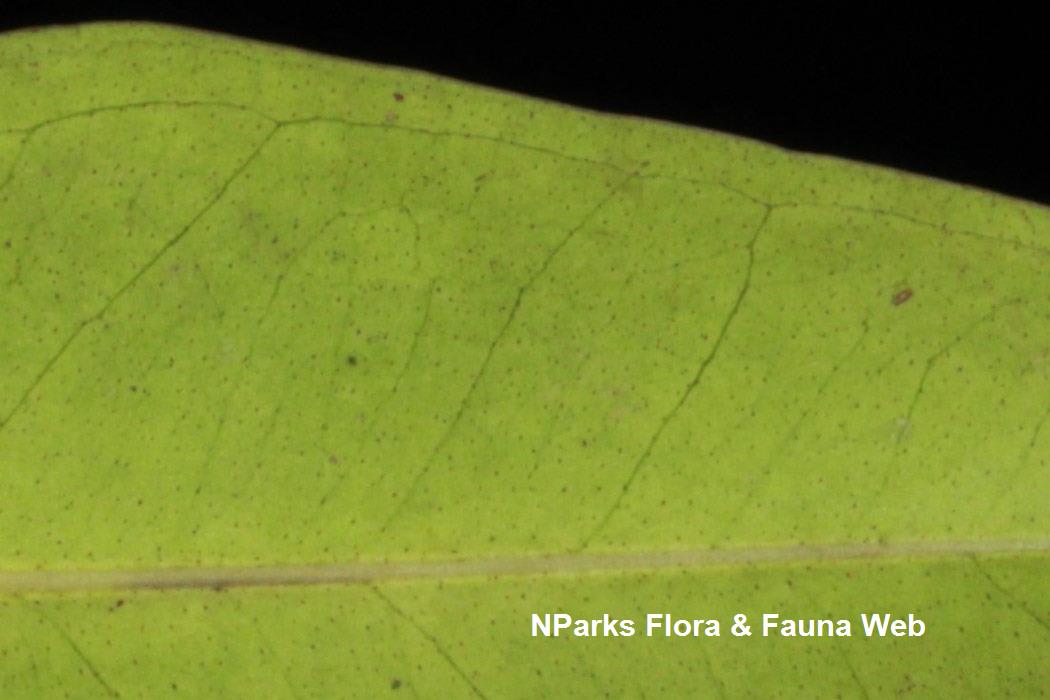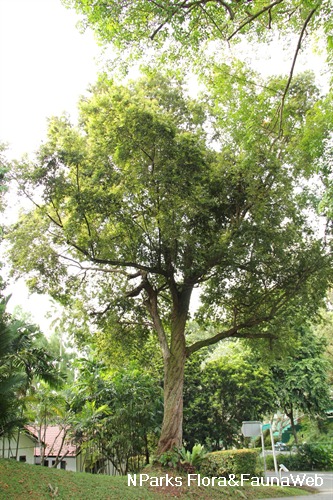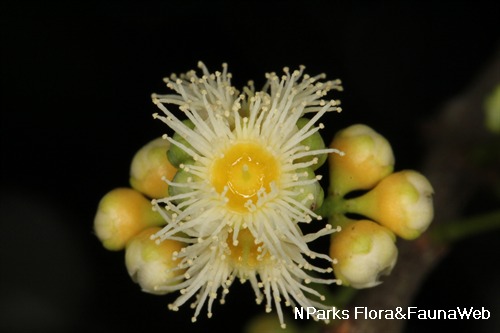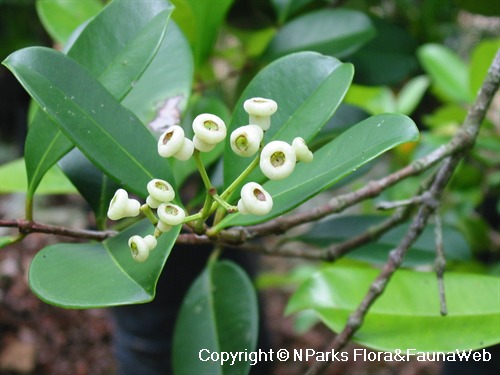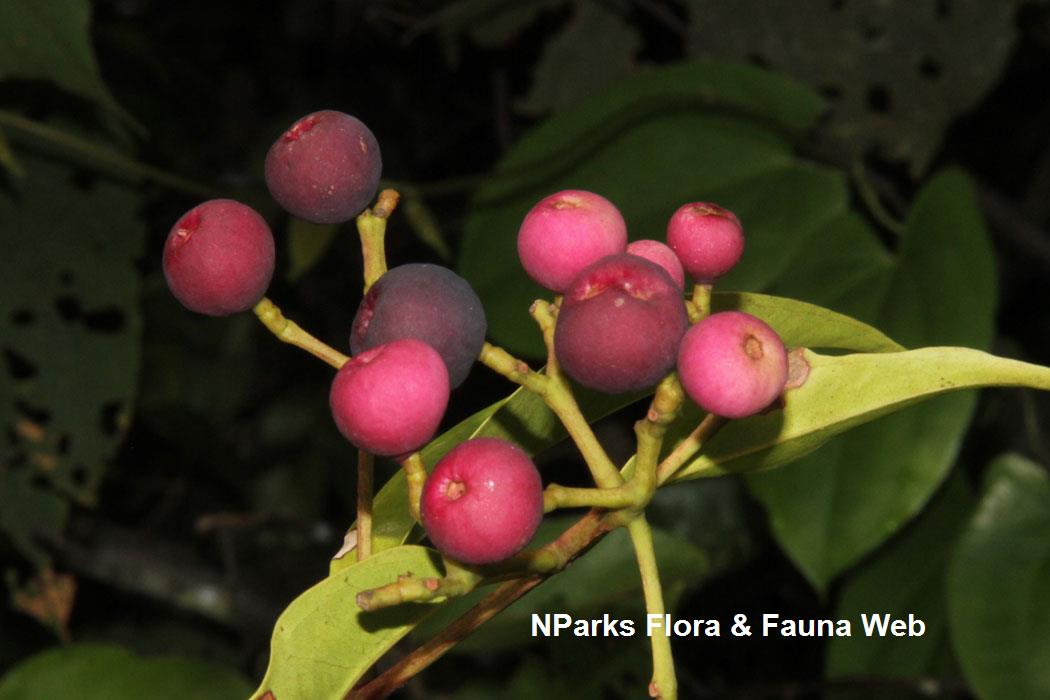
Back
Syzygium acuminatissimum (Blume) DC.
| Family Name: | Myrtaceae |
Syzygium acuminatissimum is an endangered tree in Singapore that can reach up to 35 m tall. Its leaves often feature a pointed tip measuring about 0.5 – 1 cm long. The tree produces fleshy, berry-like fruits that turn dark purple when ripe.
Name
Classifications and Characteristics
| Plant Division | Angiosperms (Flowering Seed Plants) |
|---|---|
| Plant Growth Form | Tree |
| Lifespan (in Singapore) | Perennial |
| Mode of Nutrition | Autotrophic |
| Maximum Height | 35 m |
Biogeography
| Native Distribution | From India, South China to Southeast Asia (including Singapore) and Solomon Islands. |
|---|---|
| Native Habitat | Terrestrial |
| Preferred Climate Zone | Tropical |
| Local Conservation Status | Native to Singapore (Endangered (EN)) |
Description and Ethnobotany
| Growth Form | It is a tree, up to 35 m tall, and may develop stilt roots. |
|---|---|
| Foliage | The leaves are leathery and in opposite arrangement. They are elliptic to ovate (8 – 9 cm long and 2.5 – 3 cm wide). The leaf tip is acuminate, often with a distinct acumen, about 0.5 – 1 cm long, while the leaf base is wedged-shaped (cuneate). Each leaf has 10 – 15 pairs of lateral veins which are faintly visible. The intramarginal veins lie close to margin (about 1 mm away) and are slightly looped. The petiole is short, about 0.5 cm long. When dried, leaves turn pale brown. |
| Flowers | The flowers occur in a branched cluster (panicle) at the terminal ends, reaching up to 5 cm long. They are small and sessile, with 4 sepals, 4 petals, numerous stamens and a short style (1 – 1.3 mm long). |
| Fruit | The fruit is round and slightly flattened, about 1.5 cm long and 1.2 cm wide, with a smooth surface. It is berry-like, fleshy, and turns dark purple when ripe. The calyx ring is present and minutely raised. |
| Habitat | It is found in rainforest, up to 1450 m altitude. |
| Associated Fauna | Flowers are pollinated by insects. |
| Taxonomy | It is a highly variable species, showing a wide range of forms and features. |
| Etymology | The genus epithet syzygos, in Greek, means partner or joined, referring to the paired leaves of this species. Specific epithet acuminatissimus, in Latin, means very pointed, referring to the plant’s leaf tip. |
| Ethnobotanical Uses | Timber & Products: The wood is used for crafting furniture and building boats. |
Fauna, Pollination and Dispersal
| Fauna Pollination Dispersal Associated Fauna | Bird-Attracting |
|---|---|
| Pollination Method(s) | Biotic (Fauna) |
| Seed or Spore Dispersal | Biotic (Fauna) |
Plant Care and Propagation
| Light Preference | Full Sun |
|---|---|
| Water Preference | Moderate Water |
| Plant Growth Rate | Moderate |
Foliar
| Mature Foliage Colour(s) | Green |
|---|---|
| Mature Foliage Texture(s) | Leathery |
| Foliar Type | Simple / Unifoliate |
| Foliar Arrangement Along Stem | Opposite |
| Foliar Attachment to Stem | Petiolate |
| Foliar Apex - Tip | Acuminate |
| Foliar Base | Cuneate |
Non - Foliar and Storage
| Trunk Type (Non Palm) | Woody |
|---|---|
| Root Type | Underground |
Floral (Angiosperm)
| Flower & Plant Sexuality | Bisexual Flowers |
| Flower Grouping | Cluster / Inflorescence |
|---|---|
| Flower Location | Terminal |
| Inflorescence Type | Panicle |
| Flowering Habit | Polycarpic |
Fruit, Seed and Spore
| Mature Fruit Colour(s) | Purple |
|---|---|
| Mature Fruit Texture(s) | Smooth |
| Fruit Classification | Simple Fruit |
| Fruit Type | |
| Seed Quantity Per Fruit | Few (1-5) |
References
| References | <1> Ashton, P.S. (2011). Myrtaceae s.l. In: Soepadmo, E., Saw, L.G., Chung, R.C.K. & Kiew, R. (eds) Tree Flora of Sabah and Sarawak 7: 87–330. Malaysia: Sabah Forestry Department, Forest Research Institute Malaysia (FRIM), Sarawak Forestry Department. <2> Soh, W.K., & Parnell, J. (2015) A revision of Syzygium Gaertn. (Myrtaceae) in Indochina (Cambodia, Laos and Vietnam). Adansonia sér. 3, 37 (2): 179 – 275 |
|---|
Image Repository
Others
| Master ID | 29722 |
|---|---|
| Species ID | 4031 |
| Flora Disclaimer | The information in this website has been compiled from reliable sources, such as reference works on medicinal plants. It is not a substitute for medical advice or treatment and NParks does not purport to provide any medical advice. Readers should always consult his/her physician before using or consuming a plant for medicinal purposes. |

